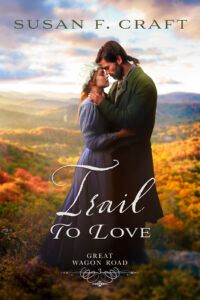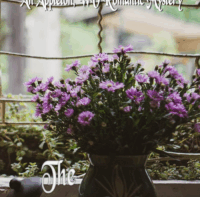Trail to Love

About the Book Trail to Love
Book: Trail to Love
Author: Susan F. Craft
Genre: Christian Historical Romance
Release date: September 17, 2024
A widowed father…a heartbroken nanny…and a wagon train journey that will change their lives forever.
Since the death of her fiancé, Anne Forbes has given up on the life she thought she’d have. After taking a role as nanny to her two young nephews, she’s grown close to her brother’s family—a replacement for the one she never had the chance to start. But when she accompanies them on the wagon trail to their new life in South Carolina, a handsome and gallant widowed father who’s also part of the group catches her eye and her heart, making her wonder if God might have plans for love for her after all.
If only the beautiful woman the man escorts didn’t have her sights set on him.
Michael Harrigan never considered remarrying after the death of his wife. No woman could ever compare. But when he meets the gentlehearted Anne while escorting his sister-in-law on their journey to the Blue Ridge Mountains, he’s taken aback by Anne’s lovely voice and her compassion. As they face the trials and adventures of life on the trail, he finds himself open to the idea of marriage for the first time in many years.
But when disaster strikes the wagon train, Michael and Anne must work side-by-side to save lives. In the midst of their struggles, can they find a way to abandon their separate trails of grief and hardship for the trail to love?
Click here to get your copy!
My Thoughts on Trail to Love
Trail to Love is a sweet historical fiction novel. It involves wagon trains and love but not necessarily in that order. I’m a lover of historical fiction. It helps me to learn more about history. And I feel that that is something we all should be doing. Learning. Every day we need to be learning. Learning something new. Whether it’s a skill or simply knowledge.
I loved this novel. It’s sweet. It has a normal boy meeting a girl. They fall in love. The end. Or is it?
This is a fun novel. I love the nanny bit and the cute kids. I’m a sucker for cute kids obviously. The time period is earlier than I normally read about. It’s the 1700’s and the wagon train is taking them to South Carolina not out west.
I loved Michael and Anne’s characters. They’ve had hardships but they’re rising above them. Making do and carrying on. This was a great read and I highly recommend you read it as well!
I have voluntarily reviewed a complimentary copy of this book which I received from Celebrate Lit. All views expressed are only my honest opinion. I was not required to write a positive review nor was I compensated in any other way. All opinions expressed are my own. I am disclosing this in accordance with the FTC regulations.
About the Author of Trail to Love
Susan F. Craft retired after a 45-year career in writing, editing, and communicating in business settings.
She authored the historical romantic suspense trilogy Women of the American Revolution—The Chamomile, Laurel, and Cassia. The Chamomile and Cassia received national Illumination Silver Awards. The Chamomile was named by the Southern Independent Booksellers Alliance as an Okra Pick and was nominated for a Christy Award.
She collaborated with the International Long Riders’ Guild Academic Foundation to compile An Equestrian Writer’s Guide (www.lrgaf.org), including almost everything you’d ever want to know about horses.
An admitted history nerd, she enjoys painting, singing, listening to music, and sitting on her porch with her dog, Steeler, watching geese eat her daylilies. She most recently took up the ukulele.
More from Susan
A History of Buttons
In my Christian Historical Romance, my main character, Anne Forbes, is a tailor and seamstress. When she arrives in Philadelphia from Scotland in 1753, she visits several shops and is amazed by the huge supply of buttons.
Buttons have been around for 3,000 years. Made from bone, horn, wood, metal, and seashells, they didn’t fasten anything but were worn for decoration.
The first buttons to be used as fasteners were connected through a loop of thread. The button and buttonhole arrived in Europe in 1200, brought back by the Crusaders.
The French, who called the button a bouton for bud or bouter to push, established the Button Makers Guild in 1250. Still used for adornment, the buttons they produced were beautiful works of art.
By the mid-1300s, tailors fashioned garments with rows of buttons with matching buttonholes.
Some outfits were adorned with thousands of buttons, making it necessary for people to hire professional dressers. Buttons became such a craze that the Church denounced them as the devil’s snare, referring to the ladies in their button-fronted dresses.
In 1520 for a meeting between King Francis I of France and King Henry VIII of England, King Francis’ clothing was bedecked with over 13,000 buttons, and King Henry’s clothing was similarly weighed down with buttons.
In the 16th century, the Puritans condemned the over-adornment of buttons as sinful, and soon the number of buttons required to be fashionable diminished, though they were made from gold, ivory, and diamonds.
By the mid-1600s, button makers used silver, ceramics, and silk and often hand-painted buttons with portraits or scenery.
The late 17th century saw the beginning of the production by French tailors of thread buttons, little balls of thread. This angered the button artisans so much that they pressured the government to pass a law fining tailors for making thread buttons. The button makers even wanted homes and wardrobes searched and suggested that fines be levied against anyone wearing thread buttons. But in la Guerre des Boutons, it’s not clear that their demands went beyond the fining of tailors.
Towards the end of the 1700s in Europe, big metallic buttons came into fashion.
At this time, Napoleon introduced the use of sleeve buttons on tunics. This time period saw the development of the double-breasted jacket. When the outside of the jacket was soiled, the wearer would unbutton it, turn the soiled surface to the inside, and re-button it.
Thread buttons were used on men’s shirts and other undergarments from the late 17th into the early 19th century. Cheaper, they wouldn’t break when laundresses scrubbed and beat the material. They were also used on shifts and undergarments because they were soft and comfortable.
Other types of thread buttons were death head buttons, star buttons, basket buttons, and Dorset buttons.
Some said that death head buttons were called that because they resembled a skull and crossbones, memento mori, a reminder that life is short and should be lived as well as possible. Dorset buttons originated in Dorset in southern England where they became a cottage industry. Families, prison inmates, and orphans were employed in the manufacture of thousands of Dorset buttons each year, which were used throughout the UK and exported all over the world.
Bone button molds, slightly domed on one side and flat on the other, were common in the mid to late 18th century. Button moulds were used to make both cloth and thread (passementerie) covered buttons.
Horn buttons were used mostly for spatterdashes and gaitered trousers. These strong durable buttons were competitive in price with other types but available in limited numbers in the 18th century since the making of them was slow.
Many colonial American buttons were made from seashells, wood, wax, and animal bones.
The bones were boiled for 12 hours, cut into small pieces, shaved around the edges and had a hole punched through them with an awl. The shape was up to the maker — round, oval, square, rectangular, or octagonal.
Brass buttons, functional and ornamental, were also popular in colonial America. In 1750 in Philadelphia, a German immigrant, Caspar Wistar, made brass buttons guaranteed for seven years. He later opened the first successful glass-making factory in the colonies.
(I want to thank the William Booth Drapers of Racine, WI, for some of the information provided in this post. Please visit their website at www.wmboothdraper.com where you’ll find a treasure trove of books about 17th and 18th-century fashion — shoes, slippers, hats, bonnets, buttons and trimmings, etc., and Packet books about sewing. Fantastic resource. Thank you, William Booth Drapers.)
Blog Stops for Trail to Love
Babbling Becky L’s Book Impressions, October 8
Simple Harvest Reads, October 9 (Guest Review from Donna Cline)
Debbie’s Dusty Deliberations, October 10
DevotedToHope, October 10
Lighthouse Academy Blog, October 11 (Guest Review from Marilyn Ridgway)
Truth and Grace Homeschool Academy, October 12
Texas Book-aholic, October 13
For Him and My Family, October 13
lakesidelivingsite, October 14
Locks, Hooks and Books, October 15
An Author’s Take, October 16
Blossoms and Blessings , October 16
Happily Managing a Household of Boys, October 17
Life on Chickadee Lane, October 18
Karen Baney Reviews, October 19
Holly’s Book Corner, October 19
Books You Can Feel Good About, October 20
Cover Lover Book Review, October 21
Pause for Tales, October 21
Giveaway for Trail to Love
To celebrate her tour, Susan is giving away the grand prize of a $50 Amazon card!
Be sure to comment on the blog stops for extra entries into the giveaway!
Click the link below to enter.








Roxanne C.
Thank you for the great review. Trail to Love sounds like a fabulous read.
Erin S.
Thanks for stopping by my blog and taking the time to read my thoughts!
Debra Pruss
Thank you so much for sharing. God bless you.
Erin S.
Thanks for stopping by my blog and taking the time to read my thoughts!